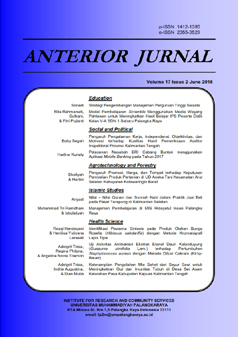Relevansi Pendekatan Teori Humanistik dalam Pelaksanaan Pendidikan Inklusi: Sebuah Kajian Film Taare Zameen Par
The Relevance of Humanistic Approach Theory in the Implementation of Inclusive Education : A Study of Movie Taare Zameen Par
DOI:
https://doi.org/10.33084/anterior.v24iSpecial-1.8672Keywords:
Taare Zameen Par, Inclussive education, Humanistic ApproachAbstract
Inclusive education is a form of educational service provided by the government for students with special needs. Inclusive education is a forum for equalizing the development of students' potential. Students with special needs often have obstacles in learning, such as those with dyslexia. The film Taare Zamen Par is a public exemplary media about the implementation of inclusive education and the problems that occur in dealing with children with special needs, such as the paradigm of society that still discredits children with special needs. The purpose of this study is to determine and evaluate the relevance of the humanistic theory approach in the implementation of inclusive education, through a study in the film Taare Zamen Par. This type of research is qualitative descriptive research. The method used in the analysis is the semiotic method. This study shows that the humanistic approach is relevant to be applied in the implementation of inclusive education. Referring to the results of the film review, it shows several forms of the humanistic approach, including; overcoming low self-esteem, getting to know students' personalities and their environment through sense and sensibility, building empathy, involving families as a support system, and exploring students' talents.
Downloads
References
Chandra, R., Firdaus, I., Ernita, A., & Roem, E. R. (2021). Analisis Semiotik Film Alangkah Lucunya Negeri Ini. XII(2).
Darma, I. P., & Rusyidi, B. (2015). Pelaksanaan Sekolah Inklusi Di Indonesia. Prosiding Penelitian Dan Pengabdian Kepada Masyarakat, 2(2), 223–227. https://doi.org/10.24198/jppm.v2i2.13530
Guillemot, F., Lacroix, F., & Nocus, I. (2022). Teachers’ attitude towards inclusive education from 2000 to 2020: An extended meta-analysis. International Journal of Educational Research Open, 3(May), 100175. https://doi.org/10.1016/j.ijedro.2022.100175
Gülsün, İ., Malinen, O.-P., Yada, A., & Savolainen, H. (2023). Exploring the role of teachers’ attitudes towards inclusive education, their self-efficacy, and collective efficacy in behaviour management in teacher behaviour. Teaching and Teacher Education, 132, 104228. https://doi.org/10.1016/j.tate.2023.104228
Hassanein, E. E. A., Alshaboul, Y. M., & Ibrahim, S. (2021). The impact of teacher preparation on preservice teachers’ attitudes toward inclusive education in Qatar. Heliyon, 7(9), e07925. https://doi.org/10.1016/j.heliyon.2021.e07925
Kurniawan, N. A. (2020). Paradigma Pendidikan Inklusi Era Society 5.0. JPD: Jurnal Pendidikan Dasar, Prosiding Seminar Dan Diskusi Nasional Pendidikan Dasar 2020, 1–6.
Kusuma, P. K. N., & Nurhayati, I. K. (2019). Analisis Semiotika Roland Barthes Pada Ritual Otonan Di Bali. Jurnal Manajemen Komunikasi, 1(2), 195. https://doi.org/10.24198/jmk.v1i2.10519
Magdalena, M., Zagoto, & Nevi, Y. (2019). Perbedaan Individu dari Gaya Belajarnya Serta Implikasinya dalam Pembelajaran. Jurnal Review Pendidikan Dan Pengajaran, 2(1), 260–263.
Muzaki, M., & Nuraldina, S. D. (2020). Implementasi Konseling Eksistensial-Humanistik untuk Meningkatkan Self-Esteem pada Siswa Terisolir di Cirebon. Prophetic : Professional, Empathy and Islamic Counseling Journal, 3(2), 197. https://doi.org/10.24235/prophetic.v3i2.7595
Nast, T. P. J., & Yarni, N. (2019). Teori Belajar Menurut Aliran Psikologi Humanistik Dan Implikasinya Dalam Pembelajaran. Jurnal Review Pendidikan Dan Pengajaran, 2(2), 270–275. https://doi.org/10.31004/jrpp.v2i2.483
Peraturan Menteri Pendidikan Nasional RI Nomor 70. (2009).
Perni, N. N. (2019). Penerapan Teori Belajar Humanistik Dalam Pembelajaran. Adi Widya: Jurnal Pendidikan Dasar, 3(2), 105. https://doi.org/10.25078/aw.v3i2.889
Schmidt, S., & Venet, M. (2012). Principals facing inclusive schooling or integration. Canadian Journal of Education, 35(1), 217–238.
Tarnoto, N. (2016). Permasalahan_Permasalahan_Yang_Dihadapi. Humanitas, 13(1), 50–61.
Udin, S., Jusnita, N., & Ali, S. U. (n.d.). THE PORTRAITS OF TEACHING STUDENTS WITH SPECIAL NEEDS IN TAARE ZAMEEN PAR MOVIE. Bilingual, 12(2), 106–113.
Uslu, M., & Girgin, Ç. (2009). Determining and evaluating the needed psychological support and education to families of children with special health care needs. Procedia - Social and Behavioral Sciences, 1(1), 1366–1371. https://doi.org/10.1016/j.sbspro.2009.01.241
Woodcock, S., Sharma, U., Subban, P., & Hitches, E. (2022). Teacher self-efficacy and inclusive education practices: Rethinking teachers’ engagement with inclusive practices. Teaching and Teacher Education, 117, 103802. https://doi.org/10.1016/j.tate.2022.103802
Yuliandri, M. (2017). Pembelajaran Inovatif di Sekolah Berdasarkan Paradigma Teori Belajar Humanistik. Journal of Moral and Civic Education, 1(2), 101–115. https://doi.org/10.24036/8851412020171264
Downloads
Published
How to Cite
Issue
Section
License
Copyright (c) 2025 Holy Ichda Wahyuni, Endah Hendarwati

This work is licensed under a Creative Commons Attribution-ShareAlike 4.0 International License.
All rights reserved. This publication may be reproduced, stored in a retrieval system, or transmitted in any form or by any means, electronic, mechanical, photocopying, recording.












